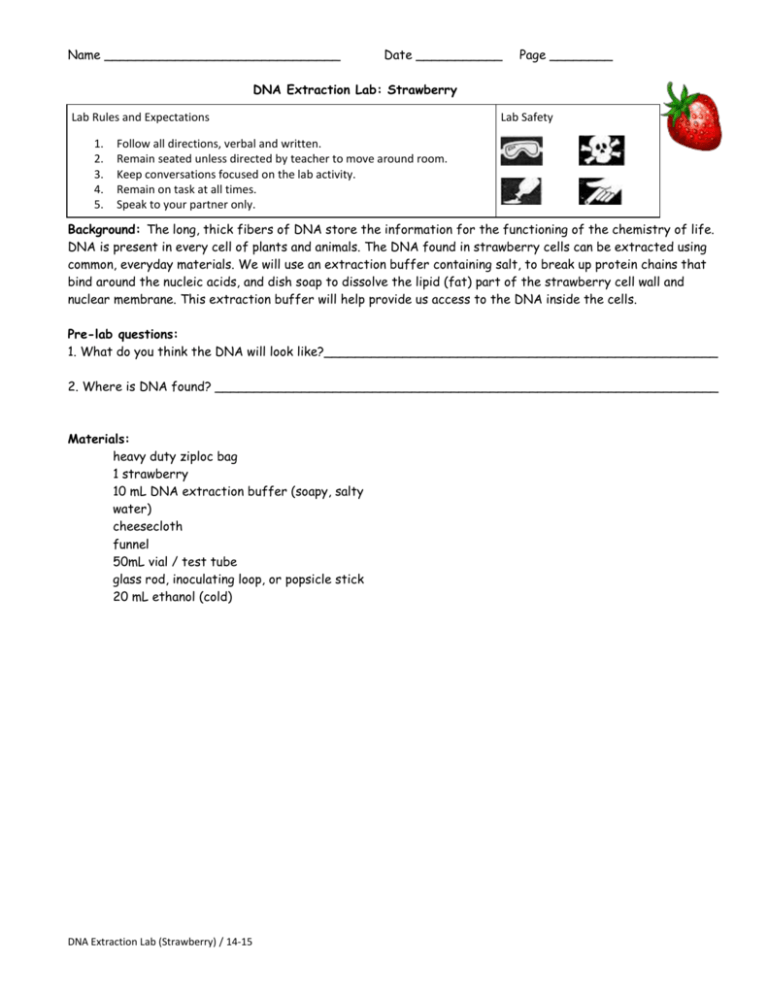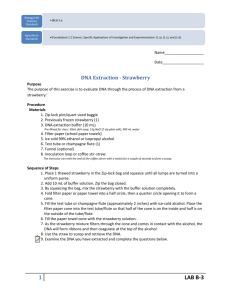Lab DNA Extraction
advertisement

Name ______________________________ Date ___________ Page ________ DNA Extraction Lab: Strawberry Lab Rules and Expectations 1. 2. 3. 4. 5. Lab Safety Follow all directions, verbal and written. Remain seated unless directed by teacher to move around room. Keep conversations focused on the lab activity. Remain on task at all times. Speak to your partner only. Background: The long, thick fibers of DNA store the information for the functioning of the chemistry of life. DNA is present in every cell of plants and animals. The DNA found in strawberry cells can be extracted using common, everyday materials. We will use an extraction buffer containing salt, to break up protein chains that bind around the nucleic acids, and dish soap to dissolve the lipid (fat) part of the strawberry cell wall and nuclear membrane. This extraction buffer will help provide us access to the DNA inside the cells. Pre-lab questions: 1. What do you think the DNA will look like?__________________________________________________ 2. Where is DNA found? ________________________________________________________________ Materials: heavy duty ziploc bag 1 strawberry 10 mL DNA extraction buffer (soapy, salty water) cheesecloth funnel 50mL vial / test tube glass rod, inoculating loop, or popsicle stick 20 mL ethanol (cold) DNA Extraction Lab (Strawberry) / 14-15 Procedure: 1. Place one strawberry in a Ziploc bag. 2. Smash/grind up the strawberry using your fist and fingers for 2 minutes. Careful not to break the bag!! 3. Add the provided 10mL of extraction buffer (salt and soap solution) to the bag. 4. Kneed/mush the strawberry in the bag again for 1 minute. 5. Assemble your filtration apparatus as shown to the right. 6. Pour the strawberry slurry into the filtration apparatus and let it drip directly into your test tube. 7. Slowly pour cold ethanol into the tube. OBSERVE 8. Dip the loop or glass rod into the tube where the strawberry extract and ethanol layers come into contact with each other. OBSERVE Observations Draw an illustration of your final product: Conclusions and Analysis 1. It is important that you understand the steps in the extraction procedure and why each step was necessary. Each step in the procedure aided in isolating the DNA from other cellular materials. Match the procedure with its function: PROCEDURE A. Filter strawberry slurry through cheesecloth B. Mush strawberry with salty/soapy solution C. Initial smashing and grinding of strawberry D. Addition of ethanol to filtered extract FUNCTION ___ To precipitate DNA from solution ___ Separate components of the cell ___ Break open the cells ___ Break up proteins and dissolve cell membranes 2. What did the DNA look like? Relate what you know about the chemical structure of DNA to what you observed today. 3. Explain what happened in the final step when you added ethanol to your strawberry extract. (Hint: DNA dissolves in water, but not in ethanol.) 4. A person cannot see a single cotton thread 100 feet away, but if you wound thousands of threads together into a rope, it would be visible much further away. Is this statement similar to our DNA extraction? Explain. 5. Why is it important for scientists to be able to remove DNA from an organism? List two reasons. DNA Extraction Lab (Strawberry) / 14-15 6. Is there DNA in your food? ________ How do you know? 7. What are some foods that might not have DNA in them? 8. If you had used strawberries that had been cooked, your results wouldn’t have been nearly as good. Why do you think this is? 9. Would the DNA from a single strawberry cell been visible to the naked eye? Why or why not? 10. The procedure that you performed today is used by many people to obtain DNA for further study. Give some examples of how DNA information is used in the world today. 11. What type of life form is a strawberry? Importance of DNA Extraction DNA extraction is a fundamental procedure in scientific laboratories around the world. By extracting DNA, scientists can learn how DNA encodes the instructions for all life processes. DNA extraction is important to the study of heredity and to the treatment of many diseases through the creation of gene therapy DNA molecules. Extracted DNA can also be used to create DNA fingerprints to help diagnose genetic diseases, solve criminal cases, identify victims of disaster and war, and establish paternity or maternity. Scientists can genetically engineer changes in DNA to create robust, disease-resistant genetically modified plants and animals. DNA extraction is also necessary in order to sequence the DNA code (order of base pairs) of different organisms (as in the Human Genome Project) and compare different species. What is “DNA extraction?” How will we break into the plant cells of a strawberry? DNA extraction is the removal of DNA from the cells of an organism. In this activity we will be removing DNA from the plant cells of a strawberry. Both a cell wall and a cell membrane surround plant cells, and plant DNA is contained within a membrane-bound nucleus. We need to use special means to break these barriers. What kind of tools or equipment would you use to remove a wall in a building? Encourage a variety of answers—hands, dynamite, a hammer, a wrecking ball, a saw, and so on. If you first knew what the wall was made of (concrete, sheet rock, brick, paper, etc.) would it help you choose what tool to use? Yes. Before we can break cell walls and cell membranes, we should ask the question, “What are cell walls and cell membranes made of?” Plant cell walls are made of cellulose, which is a tough, insoluble material that makes plants sturdy. It can be broken through physical actions. Think about chewing on a carrot. DNA Extraction Lab (Strawberry) / 14-15 Your teeth help to break open the cell walls of carrot cells. In this activity, you will mash the strawberries to break through their cell walls. Cell membranes and nuclear membranes are made up of phospholipid bilayers. What are lipids? Think of the term “liposuction.” Liposuction is the removal of fat by suction. “Lipo-” refers to fats, oils, and waxes. What do we use in everyday life that helps us to remove fats and greases from our clothes, hair, skin, or dishes? Detergents. You will treat the mashed strawberry cells with detergent to dissolve their cell membranes and nuclear membranes. This causes the cell contents and the DNA to be released. Once the cell barriers are broken, how will we get the DNA out? Once the cells are broken open, DNA and cell debris are mixed together. However, the DNA is in solution. This means that the DNA is thoroughly incorporated into the liquid (dissolved) and is not visible. What happens when you stir a teaspoon of sugar into a cup of water? The sugar dissolves in the water. It is still there; you just can’t see it. What happens when you stir a teaspoon of sand into a cup of water? The sand does not dissolve in the water; it remains separate from the water, and you can still see it. Like sand in water, a lot of the cell debris is not in solution, because the salt in the extraction buffer caused it to separate out. When the extract is poured through layers of cheesecloth, much of the cell debris is filtered out and the DNA solution passes through. DNA is insoluble in alcohol (such as ethanol and isopropanol). In order to visualize the DNA, ethanol is poured over top of the filtered liquid. The DNA then comes out of solution and is visible. What does DNA look like? What will we see? The structure of DNA is like a twisted ladder, forming what is called a double helix. The sides of the ladder are sugarphosphate groups joined by covalent bonds and the rungs are nitrogenous bases joined by hydrogen bonds. However, in order to package DNA within the nucleus of eukaryotic cells, DNA is wound around protein molecules and tightly folded into chromosomes. Can we see DNA? Yes and no. Chromosomes have been studied using microscopes, but the double helix of unraveled chromosomes is so thin that even the most powerful microscopes cannot detect it. How will we see the DNA we extract? Chromosomal DNA from a single cell is not visible by eye. When DNA is extracted from multiple cells, the amassed quantity is visible and looks like strands of mucous-like, translucent cotton. Perform this demonstration: Hold up a strand of thread to represent one single strand of chromosomal DNA. Ask the students if they can easily see the strand of thread. A single strand of thread is not easily visible by eye. Add more strands of thread to create a bundle that is easily visible to the students. This bundle represents multiple strands of chromosomal DNA. Using this kit, DNA strands will be extracted from many strawberry cells, so that the strands will be visible to the naked eye. DNA Extraction Lab (Strawberry) / 14-15








